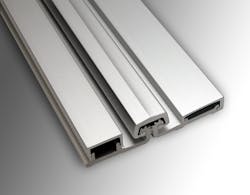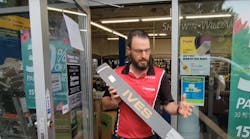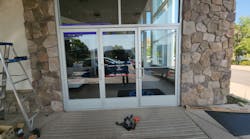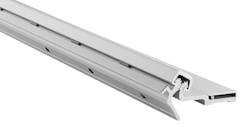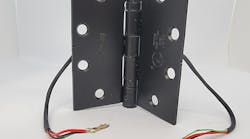Upselling door hardware and all the trappings can be a sizable source of revenue for those who choose to make an effort. Whether you pitch a new customer, thus adding to the beauty and elegance of a new, expensive set of double doors, or your lock technicians pitch these devices on service calls, this is an excellent way to add dollars to your bottom line while increasing cash flow.
Before any of this can happen, however, you must 1) stock your service trucks with a variety of door hardware goodies, and 2) train your service techs to think, “Upsell, upsell, upsell, upsell!” It also may be necessary to teach them how to ask the client if they’re interested in upgrading or adding additional hardware to their existing door(s) for a variety of reasons.
Here’s a short list of door hardware items ideal for this purpose:
- Exit devices, such as panic bars
- Hinges
- Exit alarms
- Door closers
- Kick down door holders
- Door stops
- Kick plates
- Floor-mounted door stops
- Push plates
- Pull handles
- Continuous hinges
- And more
In this Locksmith Ledger article, we’re going to discuss door hardware in the context of sales and marketing. We’ll keep the details somewhat simple so it’s easy to implement and train your field techs.
Make It Worth the Effort
The need for knowledgeable lock technicians can be intense on a local basis in some communities. At times the number of locksmith companies in these areas can outstrip the number of available techs. Add so it’s within the realm of possibility that each tech you have may actually be doing the job of two. This can be problematic besides emotionally draining, especially when they’re asked to take time to upsell at the end of each service call.
First, the question is whether it’s in your company’s best interest to detain a tech from moving on to the next service call so he/she can make a pitch. In a word, what’s in it for the company? Is there really any money in selling door hardware while on a service call?
In order to make any new sales program work, it’s necessary to have a long-term view and to be ready to commit to it. It’s also necessary to train your field techs to think like you do, and to train them on how it’s done. Just how bad do you want to create a secondary source of ready cash?
The answer to that must begin with this statement, “the issue of profitability depends on you.” Let’s say that your normal markup is 25 percent so that something that costs $100 invoices at $125. To cover the cost of stocking these pieces and parts on each service van, and to cover the additional wear and tear on the van, plus additional gasoline due to the additional weight, perhaps you can increase your markup to 35 or 40 percent, so that your $100 item now bears of price tag of $135 or $140 respectively. There’s also the issue of your techs doing a daily inventory on these items to assure that they have a fresh supply at the beginning of each day.
Besides the additional 10 to 15 percent profit, there’s also the matter of the labor needed to install them. And if time is short and a return trip is necessary, offer to make that return trip without a trip charge. The key here is to return while on a nearby service call, or one that’s along the same route.
How to Get Tech Buy-In
In an environment such as this, it’s easy for your techs to grow complacent and apathetic to the idea of selling additional hardware while they put the finishing touches to a service call.
If your techs stop at the end of each service call to pitch accessories and replacement hardware, it could mean a later-than-normal quitting time, which means the tech probably won’t make it home for supper. In a word, what’s in it for the tech?
This is a certain concern for techs who work their 40 hours and then they’re told to go home. In other words, there will be no overtime under almost any circumstances. Clearly you must get the buy-in of all your field techs in order to make this new endeavor succeed.
As to the issue of “what’s in it for the tech,” offer to provide a small percentage of the additional sales that they make. It doesn’t usually take a lot to make them happy because any additional money they earn will be money they wouldn’t have had on their paycheck otherwise.
Restoring Functionality and Enhancing Life Safety
There are two different kinds of upselling where it comes to doors. The one involves enhancing and advancing security at the door and the second involves the restoration of functionality. In this section we’ll look at the latter, whether it’s a door that needs a kickplate to cover a hole, a new set of hinges, or a door stop.
Pemko S88 Adhesive-Backed Fire/Smoke Gasketing is used on door frames to seal top and sides. Its purpose is life-safety related because it’s capable of isolating one portion of a building from another so smoke cannot migrate from one compartment to another. It’s adhesive backed; made of a high-temperature silicone; is self-extinguishing and non-toxic; seals against smoke, fire, air, sound and weather; it’s unaffected by sunlight, ozone and ultraviolet rays; it’s impervious to fungus and mildew; and it has excellent compression while allowing a door to latch easily (http://bit.ly/2nKhgig).
Common, ordinary hinges can also go bad and need replaced. The Strybuc HOPPE adjustable hinge, for example, can be adjusted both vertically (Set Hinge) and horizontally (Guide Hinge) by 1/8" for a perfect swing. Made of brass, all Set and Guide Hinges are equipped with non-removable pins for security, which means they are ideal for inswing and outswing doors. Strybuc’s specifications state that these hinges are suitable for larger doors, with a panel weight capacity of up to 330 pounds (http://bit.ly/2mgSPIQ).
Perhaps one of the best items to add security and functionality to a heavy door where the pivots are worn and in need of replacement is that of a full continuous hinge. They come in an assortment of finishes, such as brass, Nickel, and charcoal--in addition to standard and heavy duty. Most of the time you, as a locksmith, will work with surface-mount continuous hinges--‘pin and barrel’ or geared.
The SL57, manufactured by Select Hinges, for example, is a Grade 1 continuous hinge. According to Select, the SL57 “Fits narrow (7/8") frame face. Tamper resistant, removable door leaf cover. 1/16" door inset. Standard barrel nuts accommodate 1-3/8" to 1-3/4" doors. Long barrel nuts available for 2" to 2-1/4" doors. All SL57 geared continuous hinges are BHMA Grade 1 certified” (http://bit.ly/2nN5GD9).
The Rockwood 409 Wall Door Stop is another one of those products that is a necessity. Without it, untold damage can be done to sheetrock, paneling, and other wall materials. There are other types of door stops that you also can carry aboard your service vans, such as floor stops, kick down stops, and conventional screw-in door stops, most of which do not cost that much, but when a client buys one, he’ll likely replace all of the door stops in his home or business (http://bit.ly/2lwDfse). The Rockwood K1050 kickplate, and any number of other makes and models, also are a great item to sell in situations where the bottom of a door is rotted or where there’s a hole (http://bit.ly/2lC7KwZ).
The number of door hardware items available to you are too numerous to cover in a single article. Contact your local lock/hardware distributor and find out what they have to offer. There also are tons of distributors throughout the United States to work with.
Join Al Colombo on the Security & Fire, Buy and Sell Forum on Facebook today. Besides a forum designed to buy and sell goods, discussions occur there all the time. Ask questions, answer others, discuss your problems and possible solutions there as well. Go to: http://bit.ly/2AkwgWt. Questions, send an email to [email protected].
